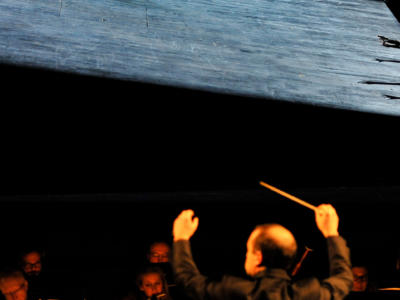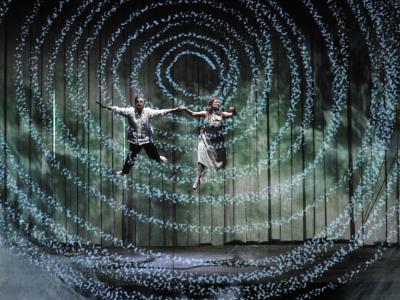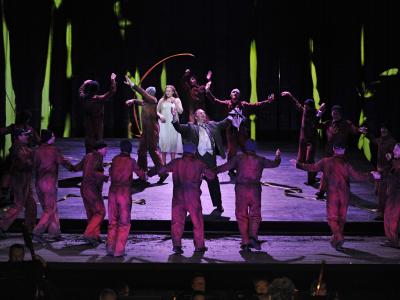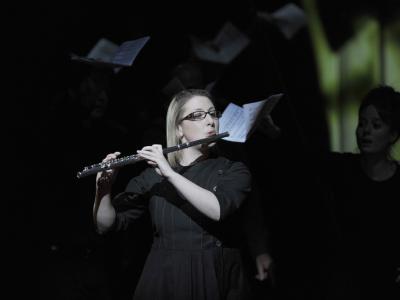The Foley Artist
Foley is the creation of everyday sounds which are added to film or television to enhance the audio. Foley is named after Jack Foley, a stuntman for silent films who added sound effects when the studio was recording the music score.
The foley artist mimics the actions of the actors on screen, recording their sounds such as footsteps, fighting, knocking on doors, rustling papers etc. In this production of The Magic Flute and unusually for opera and theatre, the sound effects are performed live by a foley artist on stage. A special booth is constructed stage left (stage directions are always given from the perspective of the performer standing on the stage looking out into the auditorium) so that the foley artist is visible to the audience throughout the production.
The foley sounds have to work in conjunction with the orchestra, singers and dialogue to enhance the performance, drawing the audience further into the story. Each sound is cued live from the actions of a performer, the timing of the spoken dialogue or a cue in the music.
Artist Profile: Ruth Sullivan, Foley Artist
Ruth works as a freelance foley artist in TV, film and theatre. She creates her own props and is skilled in knowing how to use different materials and props to create the required sound effects.
One of her recent jobs was working on Downton Abbey where the kitchen scenes are shot on a set that looks like a flagstone floor but is actually made of wood. Ruth added the sound of all the footsteps on the stone floor so that the finished broadcast appears more realistic. We interviewed her about her work below.
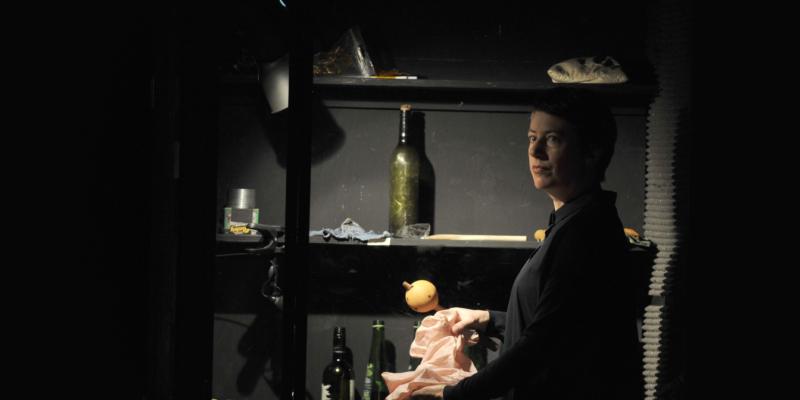
How do you work in the rehearsal room?
I will be in the rehearsal room throughout the rehearsal process, studying and learning the rhythms and gaits of individual performers and trying out sound effects to enhance their actions. I work with the director to discuss particular ideas or atmospheres they are imagining and then create the required sounds.
What is the most difficult sound to create in The Magic Flute?
The most challenging sound to get right is when Papageno is tuning his bottles to be able to play a scale on them. The singer has plastic bottles and mimes the action, creating no sound. I have to make the sounds at exactly the right moment that he hits the bottles, so have to look at the performer rather than at the bottles I am striking. There are no second chances to get it right if it is slightly mistimed!
What props will you be using for The Magic Flute?
I will have a watering can, 10 bottles, a trouser leg full of stones (to make the sound of a serpent), wooden spoon, bird caller, plastic bucket full of water, a slinky, tuning forks, shoe box of stones (for the fire),a slab of concrete and a thunder sheet (to create atmospheric sound). Everything has to have its place in the sound booth so I know where each prop is. At some points during the performance I am in the dark and have to rearrange props without making a sound.
What is your favourite prop?
I have a lantern with a squeaky handle that I use to create the sounds of an old gate or swinging pub sign. I never leave home without a pair of shoes, a cloth, a piece of leather and a game boy!
Give an example of a foley artist’s trick of the trade:
The sound of an explosion can be created by putting a plastic bag around a microphone, reducing the treble on the recording desk and then carefully manipulating the bag. The movement of air in the bag resembles thesound of an explosion or the rumble of fire

